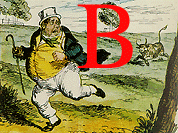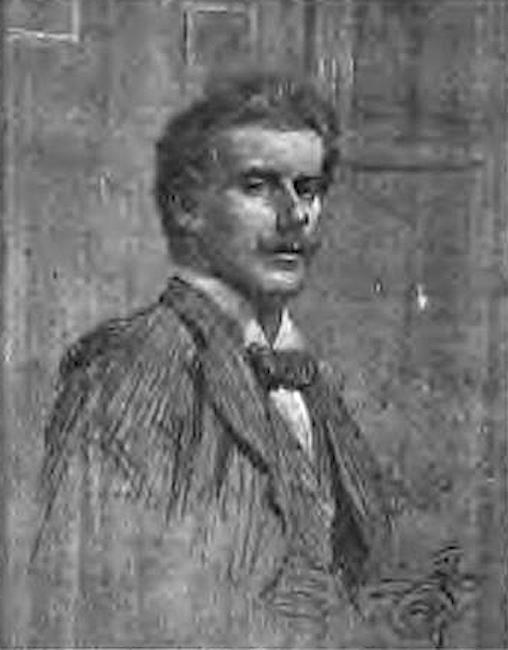
ernard Partridge was the son of Richard Partridge, a fellow of the Royal Society, and nephew of John Partridge, who had immortalised the Fine Art Commission for the Palace of Westminster and become portrait painter extraordinary to Queen Victoria. Educated at Stonyhurst, first thought of a career in architecture, then in stained glass design and other ecclesiastical decorative work (see Price 160), but was also attracted by the Fine Arts. Having trained at Heatherley's art school, he began exhibiting his watercolours at the New English Art Club. He also exhibited work elsewhere, including oil paintings and pastels: Mark Bryant mentions the Royal Academy and the Fine Art Society, and notes that he was elected RI in 1896 (48).

Bernard Partridge's Self-portrait. Source: Spielmann 564.
Since the 1880s, however, Partridge had been drawing cartoons for several popular magazines and had made his first contribution to Punch in 1891 (Spielmann 564). Linley Sambourne was chief cartoonist at the time and Partridge became his junior colleague, eventually taking the top position after Sambourne's death in 1910:
It was not only that his drawing and proportion are always entirely right that, perhaps, is to be expected in the son of the late teacher of anatomy at the Royal Academy Schools but that his handling is so graceful and dainty, his effects of light and shade so masterly, his portraiture so true, and his power of representing expression, as shown both in face and figure, so absolute. Mr. du Maurier saw in him his own successor for the time when he may be called upon to lay the pencil down; and the public recognised in him an appreciator of beauty to a degree hardly excelled by Mr. du Maurier himself. Being, moreover, as familiar with the expression of the foreigner as with that of the East-Ender or the resident of "Buckley Square," he was a recruit after Mr. Punch's own heart and interest. [Spielmann 564-55]
Partridge himself was very personable: "Handsome and courteous, he was often spoken of by his colleagues as one of the last of the Victorians" (Knox and Goldman). He was knighted in 1925, an honor that Punch historian R.G.G. Price considers "deserved and appropriate" (163). But by then his style was felt to be dated, and he had been overtaken in popularity by younger cartoonists such as David Low. These days his work also seems very enthusiastically Imperialistic, although of course that was very much of its times anyway.
Partridge's style was often theatrical. It is no surprise then to learn that he was also an actor: he appeared under the name of Bernard Gould in the first production of George Bernard Shaw's Arms and the Man, in 1894 (see Knox and Goldman). There are two oil-paintings of Sir Henry Irving by him, one in the collection of the Royal Sbakespeare Company (as King Lear at the Lyceum, in 1892) and the other, of Irving at rehearsal (in 1903), in the collection of the Museum of London.
Bibliography
Bryant, Mark. "Drawing the Line: Fine Art, Caricature and Cartoons in Britain, from Gillray to Scarfe." The British Art Journal 20, no. 2 (2019): 4252. https://www.jstor.org/stable/48616917.
Knox, E. V., and Paul Goldman. "Partridge, Sir (John) Bernard (1861-1945), cartoonist and illustrator." Oxford Dictionary of National Biography. Online ed. Web. 14 February 2024.
Price, R. G. G. A History of Punch. London: Collins, 1957.
Scully, Richard. Eminent Victorian Cartoonists. Three volumes. London: Political Cartoon Society, 2018.
Spielmann, Marion H. The History of Punch. Vol. 2. London: Punch, 1895. Internet Archive, from a copy in Harvard University Library. Web. 14 February 2024.
Created 14 February 2024